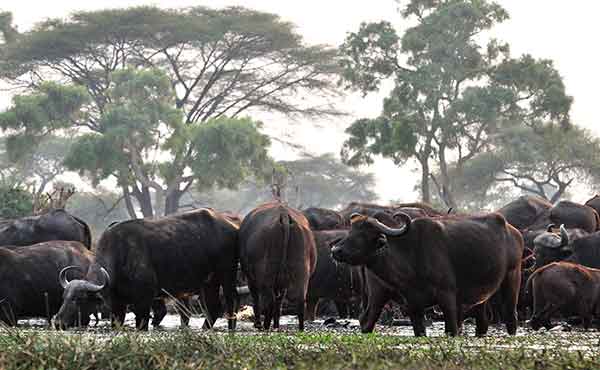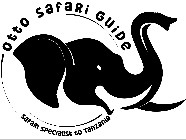Embark on an off-the-beaten-path adventure to Katavi National Park, an undiscovered gem nestled in the heart of Eastern Africa. Despite being one of the least-visited national parks, Katavi boasts some of the world’s largest populations of majestic wildlife, making it a haven for safari enthusiasts seeking an authentic and secluded experience.

What Makes Katavi Unique?
Katavi National Park, established in 1974, stands as a testament to untouched wilderness. This expansive park spans 4,471 square kilometers, encompassing diverse landscapes, from vast grasslands and woodlands to floodplains and seasonal lakes. As Tanzania’s third-largest park, Katavi offers a rare glimpse into Africa’s past, evoking a sense of pristine wilderness before human intervention.
The park derives its name from Katabi, a Wabende spirit believed to reside in a tree near Lake Katavi, where villagers seek its blessings.
Katavi National Park Wildlife – When Nature Unveils its Grandeur
Katavi truly comes to life during the dry season (June-October) when water levels drop, and floodplains transform. The focal point of wildlife activity is the Katuma River, with Lake Katavi and Lake Chada becoming vital seasonal floodplains.
Spectacle of the Hippopotamus
Home to Tanzania’s densest concentration of crocodiles and hippos, Katavi’s marshy floodplains witness a remarkable sight during the dry season. Up to 600 hippos congregate in decreasing lakes, creating a breathtaking display of territorial conflicts. Massive crocodiles bask in the sun, adding to the spectacle.
Amazing Wildlife Sightings
The Katisunga Plain, deemed the heart of the park, hosts the Big Five, including elephants, buffalo, lions, and leopards. Katavi’s expansive plains are a haven for diverse wildlife, featuring giraffes, hyenas, cheetahs, and more.
A super-herd of up to 1,000 buffalo roaming the plains in search of water is a common sight. The park is also home to around 3,000 elephants, while predators like lions and spotted hyenas roam the grasslands in pursuit of their prey. Cheetahs and leopards, though elusive, add to the park’s allure.
Birdwatching
Katavi boasts over 400 bird species, with the Katuma River attracting water-loving birds year-round. While the dry season is not the peak birdwatching period, species like the African fish eagle, African openbill, Lilac-breasted roller, Pink-backed pelican, and yellow-billed stork are frequent sightings.
Migratory birds from Europe and Northern Africa arrive during the wet season (November-April), offering birdwatchers a unique experience. However, access during the rainy season becomes challenging, and some camps close.
Katavi National Park’s Weather
With temperatures ranging from 20°C (68°F) at night to 32°C (90°F) during the day, Katavi’s climate experiences notable changes during the wet and dry seasons.
Best Time to Visit Katavi
The dry season (June-October) is ideal for wildlife sightings, including the renowned hippo pools, herds of buffalo, and predator encounters. The meadows are thinner, simplifying wildlife spotting, and lower mosquito activity reduces the risk of malaria.
While the wet season (November-April) is less favored, it offers prime birdwatching opportunities. Migratory species enhance the avian spectacle, and off-season pricing may appeal to budget-conscious travelers. The lush backdrop adds a unique charm, but challenges like road accessibility and camp closures should be considered.
Where to Stay: The Best Places to Experience Katavi
In Katavi National Park, accommodation options are limited, yet they significantly influence the safari experience. Here are some popular choices:
- Chada Katavi Camp: Nestled on the Chada Plain with Katavi forests as a backdrop, this camp offers an immersive wilderness experience. Guests can also opt for a unique fly-camping excursion, combining an overnight stay with a guided walk.
- Mbali Mbali Katavi: Formerly known as Katuma Lodge, this tented lodge in the park’s heart provides a secluded safari experience with stunning views of the Katisunga Plains.
- Katavi Wildlife Camp: Positioned against the Katisunga Plains, this camp offers breathtaking vistas and a personalized feel. Its proximity to a main airstrip enhances accessibility.
- Palahala Luxury Camp: Boasting eight spacious tents on hardwood platforms, this camp combines a traditional safari experience with luxurious touches, elevating glamping to new heights.
How to Get to Katavi National Park
The most efficient way to reach Katavi is through scheduled flights from Arusha or Dar es Salaam, operated by Safari Air Link. The 4-5 hour flight offers convenience and is the preferred choice, considering the challenging 4×4 journey lasting three days during the rainy season.
While Arusha serves as a gateway, combining a visit to Katavi with Mahale Mountains National Park, renowned for chimpanzee sightings, adds to the adventure.
Embark on the journey to Katavi National Park, where the road less traveled unveils Africa’s best-kept safari secret, promising an authentic and unspoiled wilderness encounter.
